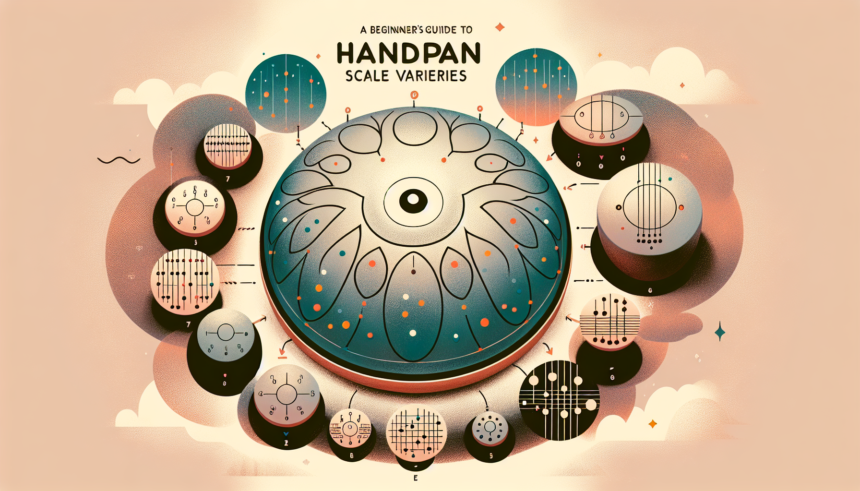The handpan is a unique and relatively new musical instrument that has captivated the hearts of musicians and listeners alike. Its mesmerizing and ethereal sound has made it popular in various music genres and meditation practices. For beginners looking to delve into the world of handpans, understanding the different scale varieties is crucial. This guide will introduce you to the basics of handpan scales and help you choose the one that best fits your musical preferences.
Understanding Handpan Scales
Handpans are essentially steel instruments crafted with a central note and several tone fields around it. These tone fields are tuned to different pitches, forming a specific scale. The scale determines the range of notes the instrument can play, and thus, its overall sound character.
Diatonic Scales
Diatonic scales are among the most straightforward and commonly used handpan scales. These scales consist of seven notes and are often found in Western music. Examples of diatonic scales include the major scale and the natural minor scale. Beginners often find diatonic scales easier to play, as they follow familiar note patterns and provide a solid foundation for learning melodies.
Pentatonic Scales
Pentatonic scales, as the name suggests, consist of five notes. These scales are commonly found in many world music traditions, including African, Asian, and Native American music. The simplicity of pentatonic scales makes them accessible to beginners. The absence of half-steps reduces the chance of playing dissonant notes, making it easier to produce harmonious and pleasing melodies.
Hexatonic Scales
Hexatonic scales contain six notes and can offer a wider range of harmonic and melodic possibilities compared to pentatonic scales. These scales are less common but can add a unique flavor to your music. Hexatonic scales are particularly appealing to intermediate players who seek to expand their musical horizons and explore new tonal landscapes.
Exotic Scales
For those who want to experiment with less conventional sounds, exotic scales provide a rich tapestry of musical possibilities. These scales often come from specific cultural or regional music traditions and can imbue your handpan playing with a distinct flavor. Examples of exotic scales include the Hijaz and the Japanese Insen scale. These scales can be more challenging for beginners but offer rewarding opportunities for advanced musicians.
Symphonic Scales
Symphonic scales are typically more complex and are designed to create intricate, layered compositions. These scales may include additional notes or microtonal intervals, providing a broader range of expressive capabilities. They are best suited for advanced players who have a firm understanding of music theory and are looking to push the boundaries of their musical expression.
Popular Handpan Scales
While there are many handpan scales to choose from, some are more popular than others. Here are a few examples that beginners might find appealing:
D Minor (Celtic Minor)
The D Minor scale, also known as the Celtic Minor, is one of the most commonly used scales in handpans. It has a melancholic yet soothing sound, making it ideal for meditative and ambient music. The notes in this scale are D, A, Bb, C, D, E, F, and G.
Kurd
The Kurd scale is another popular choice. It is similar to the D Minor scale but offers a slightly different tonal palette. The notes in the Kurd scale are D, E, F, G, A, Bb, and C. This scale is versatile and can be used for a wide range of musical styles.
Integral
The Integral scale is designed to be played intuitively, making it a great choice for beginners. It usually features a central note with a pentatonic scale around it, providing a balanced and harmonious sound. The notes in the Integral scale vary depending on the central note, but they generally follow a pentatonic pattern.
Akebono
The Akebono scale originates from Japan and offers an exotic, serene sound. It consists of the notes D, F, G, A, Bb, and C. This scale is perfect for creating contemplative and tranquil music, making it a favorite among handpan players who enjoy meditative practices.
Amara
The Amara scale is another popular choice for handpan enthusiasts. It has a dreamy and soothing quality, ideal for creating relaxing and immersive musical experiences. The notes in the Amara scale are C, E, G, A, Bb, D, and F.
Choosing the Right Handpan Scale
Choosing the right handpan scale depends on several factors, including your musical preferences, playing style, and skill level. Here are some tips to help you make the right choice:
Consider Your Musical Preferences
Think about the type of music you enjoy and want to create. If you prefer meditative and ambient music, scales like D Minor or Akebono might be suitable. For more dynamic and versatile music, consider scales like Kurd or Integral.
Skill Level
Beginners should start with simpler scales like diatonic or pentatonic scales. These scales are easier to play and provide a solid foundation for learning the handpan. As you gain more experience, you can explore more complex scales like hexatonic or symphonic scales.
Personal Connection
Ultimately, the best scale for you is the one that resonates with you on a personal level. Spend some time listening to different handpan scales and see which ones evoke an emotional response. Trust your instincts and choose the scale that feels right for you.
Where to Buy Handpans
Once you’ve decided on a scale, the next step is to purchase your handpan. There are several reputable handpan makers and retailers around the world. Here are some tips for buying your first handpan:
Research Reputable Makers
Do your research and find reputable handpan makers who are known for their quality craftsmanship. Read reviews, watch videos, and seek recommendations from other handpan players.
Attend Handpan Gatherings
Attending handpan gatherings and festivals can be a great way to try out different instruments and meet experienced players. This can help you make an informed decision and find a handpan that suits your needs.
Consider Your Budget
Handpans can be quite expensive, so it’s important to consider your budget. Start with a budget-friendly option and upgrade as you become more experienced and confident in your playing abilities.
Conclusion
The handpan is a beautiful and captivating instrument that offers a unique musical experience. Understanding the different scale varieties is essential for beginners looking to explore the world of handpan music. Whether you choose a diatonic, pentatonic, hexatonic, exotic, or symphonic scale, the most important thing is to find a scale that resonates with you and matches your musical aspirations. With the right scale and a little practice, you’ll be well on your way to creating mesmerizing melodies and enriching your musical journey.
FAQs
1. What is a handpan?
A handpan is a steel musical instrument with a central note and several tone fields around it, tuned to specific pitches to form a scale. It produces an ethereal and harmonious sound.
2. How do I choose the right handpan scale as a beginner?
As a beginner, consider starting with simpler scales like diatonic or pentatonic scales. Listen to different scales and choose one that resonates with your musical preferences and emotional response.
3. What are the most popular handpan scales?
Popular handpan scales for beginners include D Minor, Kurd, Integral, Akebono, and Amara. Each scale offers a unique sound character suitable for various musical styles.
4. Where can I buy a handpan?
You can buy a handpan from reputable handpan makers and retailers. Research makers, read reviews, attend handpan gatherings, and consider your budget before purchasing.
5. Can I learn to play the handpan on my own?
Yes, you can learn to play the handpan on your own. There are plenty of online tutorials, video lessons, and communities that can help you get started. Regular practice and experimentation with scales will enhance your skills.





